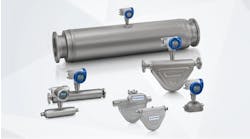Keeping workers safe in hazardous environments requires constant communication. Add to the equation that many locations are also harsh industrial settings means ensuring the right communication equipment is appropriately rated while providing the needed functionality is paramount.
To better understand how to select the right equipment, Chemical Processing spoke with Ryan Brownlee, product manager and hazardous locations expert at Pepperl+Fuchs.
Q: How is the landscape of communications in industrial locations changing, and what additional challenges does operating in a hazardous location bring?
A: If you go back far enough, people were carrying basic phones and standard land mobile radios (LMR) — your push-to-talk walkie-talkie. Now, we're seeing a move to people wanting to be connected through more office-friendly platforms like Microsoft Teams or Zoom, something that allows them to connect with anyone.
If they need to get hold of a certain expert or a supervisor, they don't have to rely on making sure that the individual on the other end has the specific platform. They can work across a variety of different platforms.
The challenge that you might have with going into a hazardous area is that you have limited choices on what you can use. Obviously, in a non-hazardous environment, there are a lot of different products, but when you're going into a hazardous area, the equipment needs to be rated to be in that hazardous area because of the increased risk of ignition and the resulting fire and hazards. The challenge is making sure that the equipment that you're picking is appropriate for the hazardous area but is also useful for what it is that you're trying to do.
Q: Compared to legacy systems, what are some of the benefits of newer systems and the methods that they offer?
A: One of the nice benefits of the new systems is that communication is happening through a standard data channel. Zoom, Teams or even Skype, they're all voice-over-IP protocols. You don't necessarily need to have somebody that's in a radio network. If I was doing something like a traditional LMR, I could only talk with people on the same radio network. So, the new systems give me connectivity across the globe. It also gives me the ability to have that connectivity through a multifunction device like a cell phone or a tablet. Now, I have the connectivity and the communications I need in the hazardous area as well as the ability to do other data-related and communications-related functionality with a single device.
It gives a lot of flexibility to the user in the field while also giving them connectivity at a global level. Platforms are available to give you push-to-talk functionality that you would have with LMR. But it's doing it over a data channel, so you can do it with a tablet or a phone. You don't need the dedicated LMR, but they'll integrate with those LMRs so that you can have people with traditional LMRs talking with people, doing a push to talk over cellular on a cellular device.
Q: What are the cons?
A: Some cons can be connectivity, especially if you're trying to do a video. They're obviously going to be a little data-heavy. Depending on the data throughput of the network that you're trying to connect to or even the ability to get that signal, that certainly can be a challenge.
Other challenges might be some of the latency. If you're trying to work with a land mobile radio system, the nice thing about those systems is that whoever developed it, usually when it was deployed in an area, the manufacturer of that LMR system did all of it. They did the radios, they did the base stations, they did all of it. And so they had obviously very tight control of the performance. When you're moving to a push-to-talk over cellular, especially if it's something that isn't tied to a carrier, you're going to have the mismatch of the device, the network, the push-to-talk application, and so you potentially end up adding some latency that you wouldn't have with a dedicated LMR.
However, that latency is getting shorter and closer to a traditional LMR experience. As more companies are deploying private LTE and private 5G networks across their facilities, they're seeing a lot of benefits. They're seeing increased security. They're seeing increased data throughput and availability, and it's much easier to deploy a 4G LTE or 5G network across a plant than having all these hotspots and all these things for repeating a Wi-Fi signal. My anticipation is that as more companies deploy private 5G and private LTE networks in their own plants, some of the latency issues due to data throughput and traffic that's on a commercial signal will go away within their plant.
Certainly, security is a concern as well. And the nice thing about moving to a private LTE or a private 5G network is that it's a much more secure method of providing cross-plant connectivity because the security within an LTE or private 5G network is inherently much more robust. So, there's going to be a lot of benefits certainly moving forward. And depending on where a particular company is, the types of scenarios that you might have today will largely be solved three years from now.
Q: Can we circle back to cybersecurity? How does that play into these new systems?
A: Cybersecurity is always a concern with plants. Some of these PTT systems are encrypting their communications over the internet. Some of them will use AES 256. This is kind of a moving target, but the companies that are putting the equipment and software together are certainly aware of cybersecurity.
And there's a variety of different platforms and systems that can be leveraged within these kinds of data-centric things because whether you're talking communication or talking data, once you get it into that environment, the computers and stuff don't care. It's just another set of ones and zeros. So, there are different ways to protect that, to secure that, to safeguard that. There are technologies coming out all the time because vulnerabilities are found, and then they're patched. Like any chain, it's only going to be as strong as your weakest link. And so, making sure that you're paying attention to all the access points into your network and making sure that everything is secure and having a plan for your security at your facility is key, and making sure that all of the different pieces are part of that, not just the communication pieces, but all of it.
Another big piece of this is the industrial Internet of Things or IIoT. People may not necessarily think about a simple little sensor to detect room temperature, but if that's connected to your network, it is a possible way for somebody to get into your network and pull data and hack into your system. So being aware of any time that you're hooking onto your network, that's another place where somebody can get in and do something nefarious if that's what you're concerned about. Having a holistic plan is certainly important.
Q: Anything you’d like to add?
A: There are many things that are available from an industrial standpoint, from a commercial or consumer grade standpoint, that would support interfacing to any one of these systems. Teams, Zoom, pick one of your push-to-talk applications, all these kinds of things. But when it comes to hazardous areas, these environments are going to be harsher and will have specific safety requirements.
You need to make sure that you have the equipment that is appropriately rated for that hazardous area. Make sure that you're doing your due diligence and that the people who are specifying the equipment to work with these systems and go into these hazardous areas understand the need and requirements for products. Be sure IT or OT or operations are saying, “Okay, these are the types of devices we're looking for. Please help us find appropriate equipment to go into the hazardous areas to keep our people safe, but still provide the functionality we're after.”
It's understanding all the different pieces that come together and making sure that you're selecting equipment to check all the boxes, not check most of the boxes, and understanding the risks that go along with that.
For more information, visit: www.pepperl-fuchs.com





